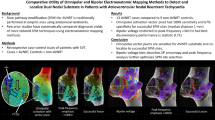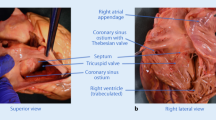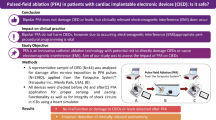Abstract
Electrophysiological stimulation and ablation is currently performed with manually deflectable catheters of different lengths and curves. Disadvantages of conventional therapy are catheter stiffness, limited local stability, risk of dislocation or perforation, and reduced tissue contact in regions with difficult access. Fluoroscopy to control catheter movement and position may require substantial radiation times.
Magnetic navigation was first applied for right heart catherization in congenital heart disease in 1991; the first electrophysiological application took place in 2003. Today, an ablation electrode with small magnets is aligned in the patient’s heart by two external magnets positioned at both sides of the thorax. Antegrade and retrograde movement of the distal catheter tip are performed via an external device on the patient's thigh. Three-dimensional MRI scans acquired before intervention can be merged with electroanatomical reconstruction, leading to further reductions of radiation burden. During treatment of supraventricular tachyarrhythmias high local precision of magnetically guided catheters, good local stability, and a substantially reduced radiation time have been reported. First applications in ventricular tachyarrhythmias and complex congenital cardiac defects indicate a comparable effect. Limitations of this therapy are the application in left atrial procedures (open irrigated ablation catheters not yet available), difficult transaortic retrograde approach (high lead flexibility), and the considerable costs.
Magnet-assisted navigation is feasible during percutaneous coronary interventions of tortuous coronary arteries and in positioning guidewires in coronary sinus side branches for resynchronisation therapy. Future applications will be complex left atrial procedures, magnetically guided cardiac stem cell therapy, local drug application, and extracardiac vessel therapy.
Zusammenfassung
In der elektrophysiologischen Diagnostik und Therapie werden Stimulations- und/oder Ablationskatheter mit unterschiedlichen Vorkrümmungen und Längen durch den Arzt mittels integrierter Zugseilsysteme über einen Handgriff bewegt. Nachteile dieser Technologie sind erhöhte Kathetersteifigkeit, eingeschränkte Stabilität im kontrahierenden Herz mit Dislokationsgefahr, selten Perforationsgefahr und ein teilweise schlechter Gewebekontakt in anatomisch ungünstig zu erreichenden Regionen des Herzens. Die erforderliche Röntgendurchleuchtung zur Kontrolle der Katheterlage führt zu einer relevanten Strahlenbelastung für Patient und Untersucher.
Die magnetische Navigation wurde erstmals 1991 bei einem Neugeborenen mit einem komplexen kongenitalen Vitium in der invasiven Diagnostik eingesetzt und 2003 zum ersten Mal während der elektrophysiologischen Untersuchung und Ablationstherapie angewandt. Heutzutage wird durch zwei externe, lateral des Thorax positionierte Magnete ein Ablationskatheter mit magnetischer Spitze im Herzen des Patienten ausgerichtet und über eine externe Führungsschiene vor- und zurückbewegt. Durch die zusätzliche Kombination mit dreidimensionaler präinterventioneller MRT-Bildgebung in Verbindung mit elektroanatomischer Rekonstruktion können die Durchleuchtungszeiten weiter reduziert werden. Bei der Behandlung von supraventrikulären Tachykardien zeigt sich eine hohe Bewegungspräzision und Stabilität mit einer deutlichen Reduktion der Strahlenbelastung. Erste Anwendungen in der Radiofrequenzablation ventrikulärer Tachykardien deuten auf eine ähnliche Effektivität hin, ebenso erste Applikationen bei komplexen kongenitalen Vitien. Limitationen stellen derzeit der eingeschränkte Einsatz bei linksatrialen Prozeduren infolge nicht verfügbarer offen gekühlter Kathetersysteme, ein aufgrund der erhöhten Katheterflexibilität erschwerter retrograd transaortaler Zugangsweg und letzlich der erhebliche Kostenaufwand dar. Neben dem Einsatz in der interventionellen Therapie komplexer Koronarstenosen und der Implantation linksventrikulärer Elektroden zur Resynchronisationstherapie sind künftige Anwendungsgebiete komplexe linksatriale Prozeduren, die Stammzelltherapie und Anwendung in anderen extrakardialen Gefäßregionen.
Similar content being viewed by others
Literatur
Aryana A, d'Avila A, Heist EK, Mela T, Singh JP, Ruskin JN, Reddy VY (2007) Remote magnetic navigation to guide endocardial and epicardial catheter mapping of scar-related ventricular tachycardia. Circulation 115:1191–1200
Atmakuri SR, Lev EI, Alviar C, Ibarra E, Raizner AE, Solomon SL, Kleiman NS (2006) Initial experience with a magnetic navigation system for percutaneous coronary intervention in complex coronary artery lesions. J Am Coll Cardiol 47:515–521
Burkhardt JD, Saliba WI, Schweikert RA, Cummings J, Natale A (2006) Remote magnetic navigation to map and ablate left coronary cusp ventricular tachycardia. J Cardiovasc Electrophysiol 17:1142–1144
Chun JK, Ernst S, Matthews S, Schmidt B, Bansch D, Boczor S, Ujeyl A, Antz M, Ouyang F, Kuck KH (2007) Remote-controlled catheter ablation of accessory pathways: results from the magnetic laboratory. Eur Heart J 28:190–195
Davis DR, Tang AS, Birnie DH, Gollob MH (2006) Successful ablation of a concealed parahisian accessory pathway using a remote magnetic navigation system following failure by conventional methods. J Interv Card Electrophysiol 16:149–151
Ernst S, Ouyang F, Linder C, Hertting K, Stahl F, Chun J, Hachiya H, Bansch D, Antz M, Kuck KH (2004) Initial experience with remote catheter ablation using a novel magnetic navigation system: magnetic remote catheter ablation. Circulation 109:1472–1475
Ernst S, Ouyang F, Linder C, Hertting K, Stahl F, Chun J, Hachiya H, Krumsdorf U, Antz M, Kuck KH (2004) Modulation of the slow pathway in the presence of a persistent left superior caval vein using the novel magnetic navigation system Niobe. Europace 6:10–14
Ernst S, Hachiya H, Chun JK, Ouyang F (2005) Remote catheter ablation of parahisian accessory pathways using a novel magnetic navigation system – a report of two cases. J Cardiovasc Electrophysiol 16:659–662
Ernst S, Chun JK, Ujeyl A, Ouyang F, Kuck KH (2007) “Sequential” mapping mimicking “simultaneous” mapping using magnetic navigation during catheter ablation of supraventricular tachycardia. Results of the Single DX Study. J Cardiovasc Electrophysiol 18(Suppl 1):S11–17
Faddis MN, Blume W, Finney J, Hall A, Rauch J, Sell J, Bae KT, Talcott M, Lindsay B (2002) Novel, magnetically guided catheter for endocardial mapping and radiofrequency catheter ablation. Circulation 106:2980–2985
Faddis MN, Chen J, Osborn J, Talcott M, Cain ME, Lindsay BD (2003) Magnetic guidance system for cardiac electrophysiology: a prospective trial of safety and efficacy in humans. J Am Coll Cardiol 42:1952–1958
Kolb C, Luik A, Hessling G, Zrenner B (2007) Magnetic catheter navigation system interference with a dualchamber pacemaker. J Cardiovasc Electrophysiol 18:1–2
Luik A, Estner H, Pflaumer A, Reents T, Wu J, Ücer E, Hessling G, Deisenhofer I, Zrenner B (2007) Automatic intracardiac mapping of the left atrium using the Niobe System. A new dimension of catheter navigation. Heart Rhythm 4:S343
Pappone C, Vicedomini G, Manguso F, Gugliotta F, Mazzone P, Gulletta S, Sora N, Sala S, Marzi A, Augello G, Livolsi L, Santagostino A, Santinelli V (2006) Robotic magnetic navigation for atrial fibrillation ablation. J Am Coll Cardiol 47:1390–1400
Pflaumer A, Hessling G, Luik A, Wu J, Zrenner B (2007) Remote magnetic catheter mapping and ablation of permanent junctional reciprocating tachycardia in a seven-year-old child. J Cardiovasc Electrophysiol 18:1–4
Ram W, Meyer H (1991) Heart catheterization in a neonate by interacting magnetic fields: a new and simple method of catheter guidance. Cathet Cardiovasc Diagn 22:317–319
Ray IB, Dukkipati S, Houghtaling C, McPherson CD, Kastelein N, Ruskin JN, Reddy VY (2007) Initial experience with a novel remote-guided magnetic catheter navigation system for left ventricular scar mapping and ablation in a porcine model of healed myocardial infarction. J Cardiovasc Electrophysiol 18:520–525
Rivero-Ayerza M, Thornton AS, Theuns DA, Scholten MF, Mekel JM, Res J, Jordaens LJ (2006) Left ventricular lead placement within a coronary sinus side branch using remote magnetic navigation of a guidewire: a feasibility study. J Cardiovasc Electrophysiol 17:128–133
Rivero-Ayerza M, Jessurun ER, van Belle Y, Theuns DA, Jordaens L (2007) Magnetically guided left ventricular lead implantation based on a virtual 3-D reconstructed image of the coronary sinus. Heart Rhythm 4:S21
Shepard RK, Ellenbogen KA (2007) Challenges and solutions for difficult implantations of CRT devices. The Role of New Technology and Techniques. J Cardiovasc Electrophysiol 18(Suppl 1):S21–25
Thornton A, Rivero-Ayerza M, Jordaens L (2007) Preliminary data showing feasibility of retrograde transaortic left atrial and pulmonary vein access using magnetic navigation. Heart Rhythm 4:S309
Thornton AS, Res J, Mekel JM, Jordaens LJ (2006) Use of advanced mapping and remote magnetic navigation to ablate left ventricular fascicular tachycardia. Pacing Clin Electrophysiol 29:685–688
Thornton AS, Jordaens L (2007) A left-sided accessory pathway revisited with remote retrograde magnetic navigation. Pacing Clin Electrophysiol 30:573–576
Thornton AS, Rivero-Ayerza M, Knops P, Jordaens LJ (2007) Magnetic navigation in left-sided AV reentrant tachycardias: preliminary results of a retrograde approach. J Cardiovasc Electrophysiol 18:467–472
Tsuchida K, Garcia-Garcia HM, van der Giessen WJ, McFadden EP, van der Ent M, Sianos G, Meulenbrug H, Ong AT, Serruys PW (2006) Guidewire navigation in coronary artery stenoses using a novel magnetic navigation system: first clinical experience. Catheter Cardiovasc Interv 67:356–363
Author information
Authors and Affiliations
Corresponding author
Rights and permissions
About this article
Cite this article
Schimpf, R., Reents, T., Hessling, G. et al. Magnetische Navigation in der elektrophysiologischen Diagnostik und Therapie. Herzschr. Elektrophys. 18, 157–165 (2007). https://doi.org/10.1007/s00399-007-0575-8
Received:
Accepted:
Issue Date:
DOI: https://doi.org/10.1007/s00399-007-0575-8




